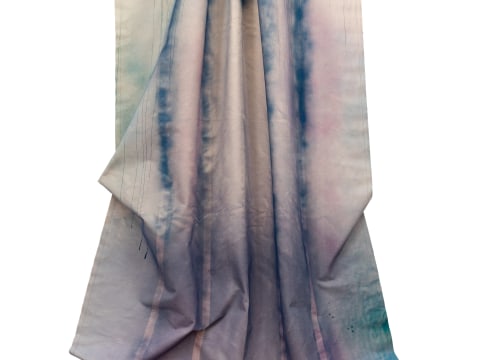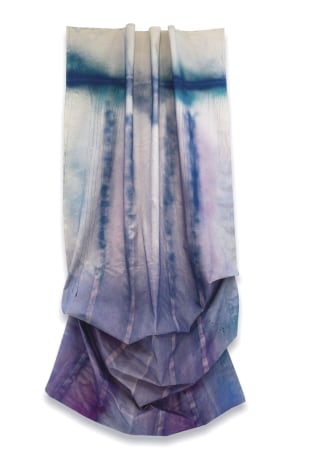
"Can Women Have One-Man Shows?": Nina Yankowitz Paintings, 1960s–70s
Eric Firestone Gallery
40 Great Jones | New York, NY
September 9–October 22, 2022
Opening Reception: Friday, September 9 | 6:00–8:00 PM
Eric Firestone Gallery announced today its representation of Nina Yankowitz (b. 1946), a founding member of the iconic feminist collective Heresies, who since the 1960s has produced a daring body of abstract work imbued with formal and social justice concerns. Eric Firestone Gallery will feature her dynamic unstretched paintings in its debut solo exhibition on the artist, “Can Women Have One-Man Shows?”: Nina Yankowitz Paintings, 1960s–70s, on view from September 9 through October 15.
“Can Women Have One-Man Shows?” revisits a historic dialogue between critics about Yankowitz’s 1971 presentation at Kornblee Gallery. In his New York Times review, critic James R. Mellow called that exhibition her “one-man show.” He went on to describe her Draped Paintings and Pleated Paintings as “seductive” and “fancifully draped, somewhat feminine—a painting en déshabille.” In response, feminist critic Cindy Nemser penned a letter to the editor entitled “Can Women Have ‘One-Man’ Shows?”, which challenged the thinly veiled sexism of Mellow’s article. As Nemser wrote, “I sincerely doubt that Mellow would use this kind of coy language if the works he was reviewing were man-made.”
Reexamining this history of the postwar art world that women practitioners faced, Eric Firestone Gallery showcases Yankowitz’s bodies of work from that period in this exhibition. Visitors encounter the artist’s expressive Draped Paintings and Pleated Paintings hung on the wall in loose soft folds as well as examples from another unstretched series, Dilated Grain Readings. These large-scale works demonstrate how the artist moved deftly between improvisation and composition; between precise marks and expansive fields of color; between formal control and stylistic liberation. This presentation marks an important opportunity to reevaluate the artist’s enduring innovation.
Born and raised in New Jersey, Yankowitz came of age at the height of the American counterculture movement. As a high school student hanging around legendary music venues in Greenwich Village, she learned of Group 212: a collective of artists and performers with whom she spent the summer of 1968 in Woodstock, New York. Yankowitz found inspiration in Group 212’s political consciousness, intuitive experimentation, and mixing of art and music.
Yankowitz studied at Temple University and the New School for Social Research before graduating in Fine Art from the School of Visual Arts. She began making her Draped Paintings and Pleated Paintings in the late 1960s. Leaving behind painting’s drum-taut support, the Draped Paintings are unstretched canvases. Yankowitz used a spray gun to create mists of paint producing atmospheric expanses and bleeding bands of color. She then hung these works in loose soft folds cascading down or horizontally across the wall. The artist created her Pleated Paintings in a similar manner, yet instead ran lengths of canvas through pleating machines before spraying them with paint. These bodies of work have a sculptural presence. By eschewing the historical precedent of wood stretcher bars, the paintings (if desired) can shift in shape each time they are mounted and assume a variety of identities. Yankowitz installed her Draped Paintings and Pleated Paintings in 1967 and 1968 at the renowned Kornblee Gallery, where she later presented important solo shows in 1969–70 and 1971.
Only a few years after graduating from the School of Visual Arts, Yankowitz was invited to participate in the inaugural 1973 Whitney Biennial, for which she presented a work from her Painted Thread Reading series. During the mid-1970s, she began attending meetings with a group of feminist artists and writers that would become the Heresies mother collective, producing Heresies: A Feminist Publication on Art and Politics from 1977–93. The group sought to challenge patriarchal art institutions and systems.
In 1973, Yankowitz moved from her Tribeca studio to a loft building on Spring Street in lower Manhattan, where she began another important series. To create her Dilated Grain Readings, the artist squeezed paint from plastic bottles onto unstretched raw linen that she had woven with tight and loose grain patterns for outlining with paint. They seem like color notated musical scores. Indeed, sound informs some of her work. As Yankowitz once explained, “When I hear sound I see color, and when I see color I hear sound.”
During that period, Yankowitz’s works were exhibited and reviewed alongside contemporaries such as the late Sam Gilliam. Like Gilliam, Yankowitz expanded on Abstract Expressionism, pushing the movement to encompass dramatically new forms and modes of presentation. Yet Yankowitz also introduced principles from the Feminist Art Movement into her practice. She incorporated sewing, pleating, and other handicraft techniques maligned as feminine into her painterly process—challenging the notion of “women’s work.”
Yankowitz also used non-representation as a vehicle for her sociopolitical concerns. Her embracement of abstraction set her apart from some other feminist artists. As Yankowitz explained: “At the time, I didn't believe you had to reference female issues only by using female-specific imagery to be a feminist artist. But later, looking back to working with Heresies, I recognized the importance of projecting a strong unified voice demanding equal acceptance for a female imagery was necessary to make any change.”
Since the 1970s, Yankowitz has also been a staple of the booming postwar art scene on the East End of Long Island, where Eric Firestone Gallery operates its flagship gallery and its warehouse space called The Garage. During the ‘70s, Yankowitz spent long periods of time in Southampton at the summer rentals of friends such as artist Hermine Freed and architect James Ingo Freed, and artist Marjorie Strider. The sonic environment there influenced facets of her practice. Yankowitz recalls being struck by the melodies produced by birds and insects, in response to which she created a series of painted scores and audio recordings that evoke the symphonic-like sounds of various voices. Eventually she purchased a house in Sag Harbor in 1993. The artist now lives and works in both Sag Harbor and New York City.
Yankowitz’s works are found in public collections including the Franklin Furnace Collection at The Museum of Modern Art, New York, NY; Guild Hall, East Hampton, NY; Fine Arts Museum of San Francisco, San Francisco, CA; Virginia Museum of History & Culture, Richmond, VA; and the Smith College Museum of Art, Northampton, MA. Her archival materials are found in the Archives of American Art, Smithsonian Institution, Washington, D.C..
Yankowitz has been featured in exhibitions or presented installations at institutions such as The Aldrich Contemporary Art Museum, Ridgefield, CT (1970); Emily Lowe Gallery, Hofstra University, Hempstead, NY (1970); Art Institute of Chicago, Chicago, IL (1972); Kunsthaus, Hamburg, Germany (1972); Storm King Art Center, New Windsor, NY (1973); Bronx Museum of Art, New York, NY (1978); MoMA PS1, New York, NY (1982); 51st Street Lexington Avenue Subway, commissioned by the Metropolitan Transportation Authority, New York, NY (1987); Katonah Museum of Art, Katonah, NY (1990); The Bass Museum of Art, Miami, FL (1996); Art in General, New York, NY (1998); Parrish Art Museum, Water Mill, NY (1998); Guild Hall, East Hampton, NY (2005; 2014); Museum of Modern Art of Ukraine, Kyiv, Ukraine (2011); The Museum of Modern Art, New York, NY (2013); and the Smith College Museum of Art, Northampton, MA (2016), among many others.
For further information and images, contact Resnicow and Associates at efg@resnicow.com or call (213) 671–5161

